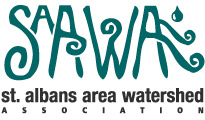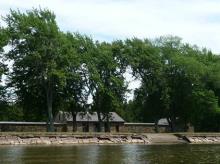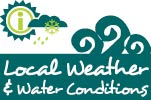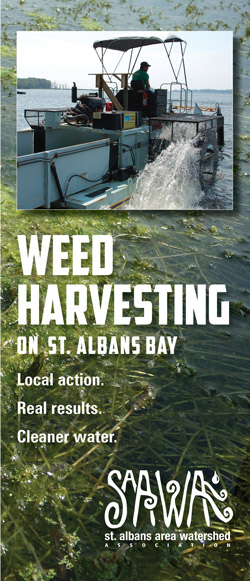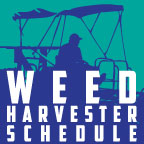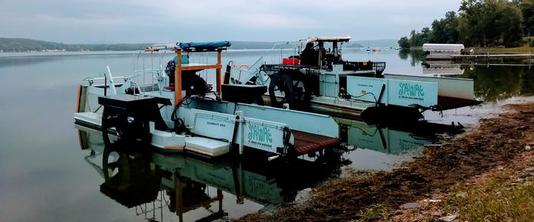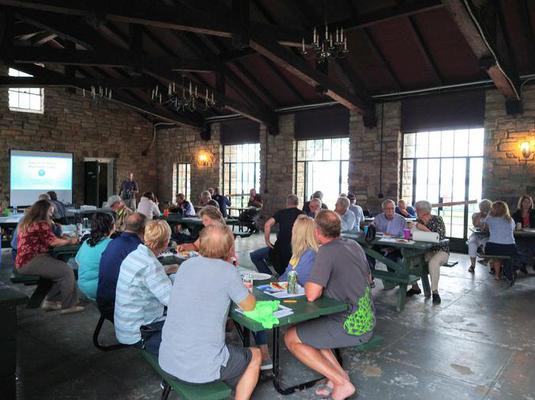Restore the Bay
Tees Still Available
Get yours today!
We have a limited number of Restore the Bay performance tees in adult, womens and youth sizes!
They are cool,
comfortable and
highly visible.
Wear with pride
while spreading
the message that
you care about
St. Albans Bay!
They make great gifts as well.
Restore the Bay
tee shirt special:
$10
if you would like
to purchase a shirt.
We will soon be posting an approcimate schedule of where the Harvester will be working this summer. At the beginning of the year, it will start where there seems to be the greatest need. Watch this space for schedule updates. If you would like to coordinate shore clean-up with the operators, please contact Steve Cushing at 782-5675.
SAAWA Annual Meeting 2021
Thanks to everyone who turned out for our St. Albans Area Watershed Association’s Annual Meeting! So good to see everyone again by the Bay!
New officers were elected: Steve Langevin, president; Jeff Moulton, vice president; Jeff Koldys, treasurer and Brittany Carter, secretary.
Updates were provided for weed harvesting; SAAWA budget; Lazy Lady Island reclamation; UVM study, latest Newsletter (click to download), and the summer membership drive.
Special thanks to our guest speaker, Emmalee Cherington from the St. Albans Town who explained how the new storm water utility will be implemented and tax money spent. It was an informative talk, and we are looking forward to seeing projects develop and learning more.
In addition, special shout out to Mill River Brewing for tending some great beers at the event.
Also in the news, the St. Albans Messenger reported yesterday how “Vermont farmers are responsible for the largest reduction of phosphorus entering Lake Champlain in the past five years. “ It’s amazing what can be done when no one cares who gets the credit:).
SAAWA is an all-volunteer organization. We could really use your your help to continue to advocate for clean water and push for more effective action
to restore the lake. Here in Franklin County, the water of St. Albans Bay continues to be impaired and progress continues to be slow.
Please make this the year that you jump in and join us. It's a great way to learn more about water quality issues and volunteer in the grass roots of your community to push for real change and clean water. Come to a Board Meeting! Please email us if you would like to attend and we will include you in the meeting notices. Click here to subscribe to our e-list.
We could use your help with membership, website management, Facebook posts, issue research, newsletter production and much more. If you would like to help, please email Steve Langevin: [email protected].
.........................................................................................................................
2021 Weed Harvesting Season Report
The St. Albans Area Watershed Association (SAAWA) began the 18th season of weed harvesting on July 20, 2021. Between July 20th and August 20th the weed harvester worked in the area along Ferrand Road and Bingham Shore Road. The weed concentration was extremely dense and 14 to 15 loads were harvested each day during the first four weeks. During weeks 5 and six the number of loads decreased to 7 to 8 loads per day. On August 23 the operation moved to Hathaway Point.
The large weed harvester, an Aquarius Systems EH-420 having a capacity of 420 bushels, has been the only weed harvester in operation. The smaller Aquamarine H5-200 has not been in use because the tractor drawn trailer is only able to transport one large load at a time; and to off load each load in the time it takes for the large weed harvester to bring in another load. In areas with less abundant weed growth, both machines will be in operation.
Andy Pelletier is the daily supervisor of the operation. This will be his 12th season of operating and maintaining the equipment. Gary Trivento operates the weed harvester and this is his 3rd season on the lake.
The water quality has remained relatively good during this year. The Bay experienced a blue/green algae bloom on Sunday August 8th and another algae bloom on Friday and Saturday, August 20th and 21st. These algae blooms occurred during calm condition accompanied with high temperatures, and dissipated when winds return creating wave action.
Funding continues to be provided by the Town of St. Albans, the City of St. Albans, the Town of Georgia and a grant from the State of Vermont. SAAWA is grateful for the financial support we receive annually and support from our membership.
We encourage shoreline property owners to inform
Steve Cushing, weed harvesting coordinator, of problem areas
you experience around the Bay. We would be very happy to
work with individuals to clean the shoreline of accumulated weeds.
Steve can be reached at 782-5675.
Contributions can be mailed to St. Albans Area Watershed Association,
P.O. Box 1567, St. Albans, VT 05478 or click to donate online securely with a credit card via Paypal.
Cormorants on Lazy Lady Island
Since about 2016, double-crested cormorants have been taking up
residence on Lazy Lady Island in St.Albans Bay. (See article in the St.
they have been nesting unimpeded and are taking a toll on the trees
and vegetation on the island. The birds destroy the trees for their nests,
and their guano burns the vegetation under the trees and they damage
water quality. They discourage nesting herons on the island. Once the
trees are destroyed, ring necked gulls will move in and the island will be lost.
Left unchecked, Lazy Lady risks complete defoliation within the next
3-5 years. SAAWA was finally successful in connecting with the new owners
of the island and helped them visit the location. They have taken first steps to
resolve the cormorant problem, and exploring with help from Fish and Wildlife,
ways to bring the island back. We are grateful for their concern and hope to begin
to see some progress next year.
Cyanobacteria Information
Weed growth and hot temperatures may create hazardous blue green algae conditions this summer. When cyanobacteria is present, it is best to avoid contact. You can find information on identifying cyanobacteria at healthvermont.gov. You can also access a cyanobacteria tracker map here.
Glyphosate: Increasing phosphorus runoff and toxic too?
SAAWA has been looking at work done on the effects of the broad-spectrum herbicide glyphosate and the damage its increasing use may have created in our watershed. Sold under the name Roundup, but also used in other herbicide formulations, farmers and property owners use glyphosate for weed control. Concerns are being raised not only regarding the toxic potential of this substance, but also regarding the effect that surfactants in the glyphosate solutions have on speeding delivery of phosphorus and other nutrients into the lake. Studies are being done around Lake Erie which seem to connect the use of glyphosate to a dramatic increase in nutrient runoff. In our area, densely planted with corn, this is a great concern. We believe this is a subject that has been largely ignored, despite widespread use in our watershed, and the Board is working to bring attention to what is potentially a huge problem in our area.
Food for Thought... Rethinking Agriculture in Vermont
Regeneration Vermont has been promoting an idea that agriculture in Vermont needs to change -- for the benefit of farmers, consumers and the environment. SAAWA has been raising this issue for some time now. We are not anti-farm. We want to see farms continue to thrive in Vermont. There are many farmers spendiing money and effort trying to do the right thing, but the rise of CAFO and monocropped corn in our area has certainly not been compatible with clean water. We see it daily. Not only does not seem profitable for the farmers, it requires increased pesticide use, contributes to runoff and phosphorus load. This is a discussion that needs to be had and we believe Vermont can do better.
To learn more, visit RegenerationVermont.org.
Vermont agriculture exists in what seems to be two parallel universes, one in our minds and the other in reality. When people are asked to think about or imagine Vermont farming, they’ll inevitably mention grass and pastures and grazing cows, all with a perfect blue sky and just the right puffy clouds. It’s a well-marketed image, and comes attached to flavors like Cherry Garcia and slogans like “farmer owned.”
But the reality is much different. Because a vast majority of Vermont’s agriculture – more than 70 percent — is all about commodity-driven, nonorganic dairy production, where GMO crops dominate, cows are on concrete, gorged and fully dosed with an array of pharmaceuticals, fields are bathed in toxic pesticides, and our waterways are declared impaired as a result of the nitrogen and phosphorus-rich farm runoff.
Future plans
SAAWA is focused on real, in-lake cleanup measures, as well as pressing for better land-use practices in the watershed. We are currently exploring the addition of a shoreline conveyor to make weed harvesting more efficient, methods of transporting weeds farther from the watershed, and better ways to combat blue-green algae which recent studies increasingly show may be a serious health hazard.
You can support these efforts with your tax-deductible donation to the harvester fund.
SAAWA is not an organization of property owners. Our goal is to serve as a voice for all of us in this watershed (shore, city and town) to express the need for change, and to coordinate action for real, in-lake clean-up. We are tired of studies and participation in voluntary programs has not been successful. We have, and will continue to advocate for requirements to improve agricultural land use practices
and for greater investment in enforcement.
Volunteer for a committee or attend the next meeting of the Board Anyone with an interest in serving on the Board is invited to attend a Board meeting.
The St. Albans Area Watershed Association was created in 2002 with the primary goal of restoring the water quality of St. Albans Bay and the surrounding watershed. We are a grassroots group of individuals -- young and old -- who love the lake and want to see crystal clear waters return to the Bay for the enjoyment and health of people and animals.
St. Albans Area Watershed Association | P.O. Box 1567, St. Albans VT 05478 | email: [email protected]
SAAWA wants to see real change happen in Saint Albans Bay.
Join your neighbors to take action. Support weed harvesting
and algae remediation in the Bay and better land use practices.
Please support
the Harvester Fund
Through private donations and municipal grants from the City and Town of St. Albans, and the Town of Georgia, SAAWA is able to operate two harvesters on St. Albans Bay beginning in July, usually around the 15th. We have restored both large and small harvesters and continue to maintain and operate them to reduce weeds in St. Albans Bay.
2018 brought greater than anticipated maintenance costs so we will be soliciting donations from individuals, particularly near the shoreline, to help replace those funds and keep the harvesters running. If you are able to help with this campaign, either by donating or soliciting your neighbors, please email us.
Many thanks to all who continue to renew their membership, make donations and contribute to the Harvester fund. Your contributions make it possible to continue to work of cleaning up the lake and keep excess weeds under control.
The St. Albans Area Watershed Association is a non-profit corporation with tax exempt status under IRS section 501(c)(3) TIN 41-2196343. All Donations are Tax Deductible.
SAAWA Board Meetings
are scheduled monthly
on Wednesdays at 5:30 pm
Next meeting :
Wed., Sept. 22
Your participation
is welcome!
Learn More: St. Albans Bay Weed Harvesting Video


